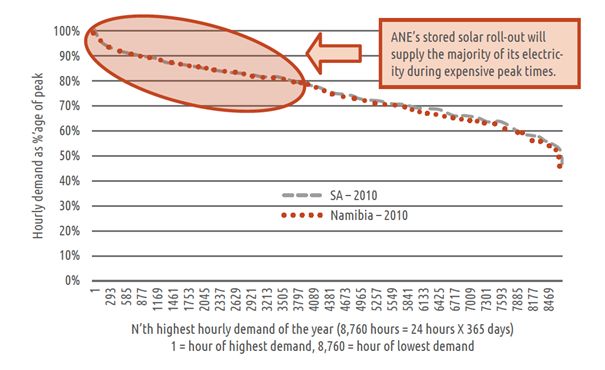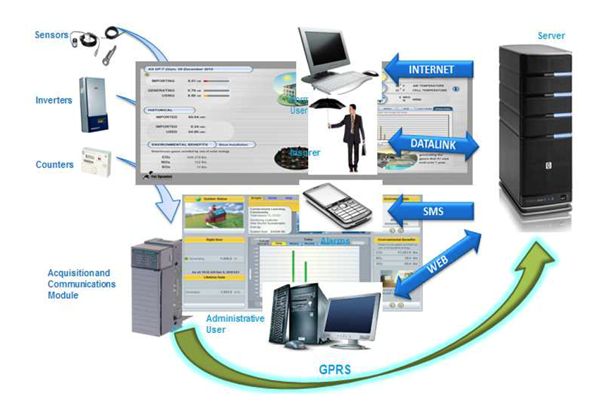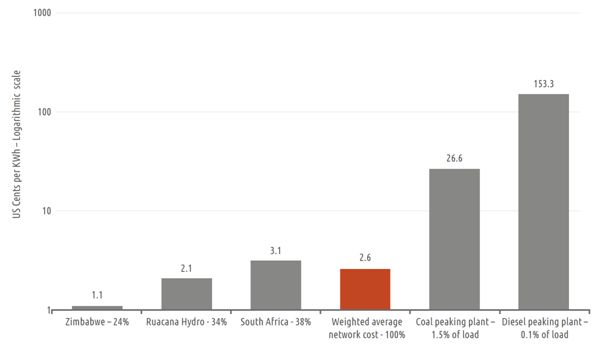Pre-feasibility study into solar energy rollout in Namibia
9. ANE’s 4-step technology development roadmap for the micro-generation programme
On-grid micro-generation can play an important role in providing power when the grid most needs it. This is especially the case with solar water heaters, where the cost per KWh over the 15 year life of the system is 5 USc per KWh, 1/3rd of the currency electricity price and one sixth of the forecast electricity price in 2015.

Namibian and South African electricity demand levels over the 8,760 hours in 2010
To achieve this strategy, the following technology interventions are being designed:
| Step 1 | Step 2 | Step 3 | Step 4 |
|---|---|---|---|
| Solar remote monitoring unit developed
Insurance tie in (completed) |
Theft proofing
Add wind, and hybrids Solar water heating Battery storage monitoring |
Theft proof integration for solar PV
Prepayment integration with mobile payments platform |
Integration with grid for peak shaving with SMS notification
Vertical spinning capacity (ultrashort term supply to grid to smooth demand) |
Step 1 – Remote monitoring and insurance add-on
ANE’s micro-generation partner has developed a remote monitoring system that currently monitors performance and irradiation levels, enabling an insurer to ensure performance. This greatly reduces financing costs. The system works as follows:

The Prophecy Solar Remote Monitoring System
Step 2 – Theft proofing, adding wind, solar water heating and battery storage monitoring
Solar panels are valuable – a single on-roof solar panel is worth more than a years’ earnings of 40% of the population. Experience of solar installers in Africa (mainly for the mobile telecoms industry) is that theft is a major problem. It is an even bigger problem when the panel is being financed, so needs to be insured.
ANE has developed the Solar Remote Monitoring System (SMRU) with C2I2 an innovation company in South Africa, which will integrate wiring within the panel itself to a remote code and a local access code. If a panel is stolen, it will be of no use except in the installation where the embedded IT allows for activation of use remotely.
The circuit board is exceptionally versatile and can take up to 200 data inputs, so wind data, solar water heating monitoring and battery storage and dispatching will be included. The battery dispatching will also assist with dealing with shading – solar PV is sensitive to shade as a small amount of shade affects the whole array due to panels being connected in series. The innovative configuration of the battery enables the panels to feed the battery individually.
Step 3 – adding pre-payment capability
Only 50% of Namibia’s population has access to a bank account, and 20% of households would be credit worthy enough for a loan from ANE’s Revolving Carbon Fund. As a fundamental aim of the programme is universal affordable access, ANE will use the CSR Trust to offer pre-paid solar panels and solar water heating, where the service is paid for on a mobile phone and topped up – at a price of half of the cost of electricity from the grid. Pre-payments will be re-invested in community development, so the local peer pressure will help to foster a sense of community, as people “invest” in their own communal social development, at the same time they develop a banking history and credit worthiness.
Step 4 – SMS dispatching – virtual spinning reserve
Residential customers are difficult for the grid to cater for as their usage tends to be in the morning and evening peaks, which are the most expensive times for generators to provide electricity. See below:

Cost of components of Namibian generation supply
The SMRU system will ensure that houses with micro-generation will use their storage at the most expensive times for the grid, avoiding the need for hugely expensive peaking plants, such as Paratus which costs $1.53 per hour – 60 times the average cost to generation on the grid.
The SMS approach offers other advantages
- Speed – SMSs can be dispatched within one minute, so the system can be used to smooth demand onto the grid – and replaces expensive “spinning capacity” i.e. expensive grid capacity that can be bought online in less than ten minutes.
- Avoided transmission losses – the battery storage will reduce loads on the grid at high demand times by using the on-site battery, so transmission losses from the grid on this electricity will be zero. In extreme cases, where supply is obtained from far-off grids such DRC, losses can be 20% or 3 times average.
- Awareness and time of use tariffs – this technology paves the way for time of use tariffs, where customers are charged based on when they use electricity, encouraging energy saving through a market mechanism.


0 Comments